By Kurt Lawton
Among the many key cover crop takeaway lessons, an overall theme was clear: “The most important rule: Plan your cover crop the same way you plan a cash crop—whether your goal is soil health and water infiltration, weed control, or livestock grazing.”
Cover Crop Boot Camp 2.0 was a ‘virtual’ success thanks to knowledgeable presenters and more than 300 farmers who logged on and participated. Practical Farmers of Iowa (PFI) coordinated this second-annual event, a key initiative developed by the Cover Crops Working Group of the Conservation Infrastructure Initiative.
The agenda covered three main topics: Digging into soil health, suppressing weeds, and livestock lessons.
Key Takeaways: Digging into Soil Health
Andrea Basche, University of Nebraska agronomist
- From a very wet 2019 to a drought in 2020, weather extremes can be managed with cover crops that increase water infiltration.
- Soil health practices that keep living roots in the soil help turn soil into sponges (improved soil aggregates) to reduce flood and drought impact.
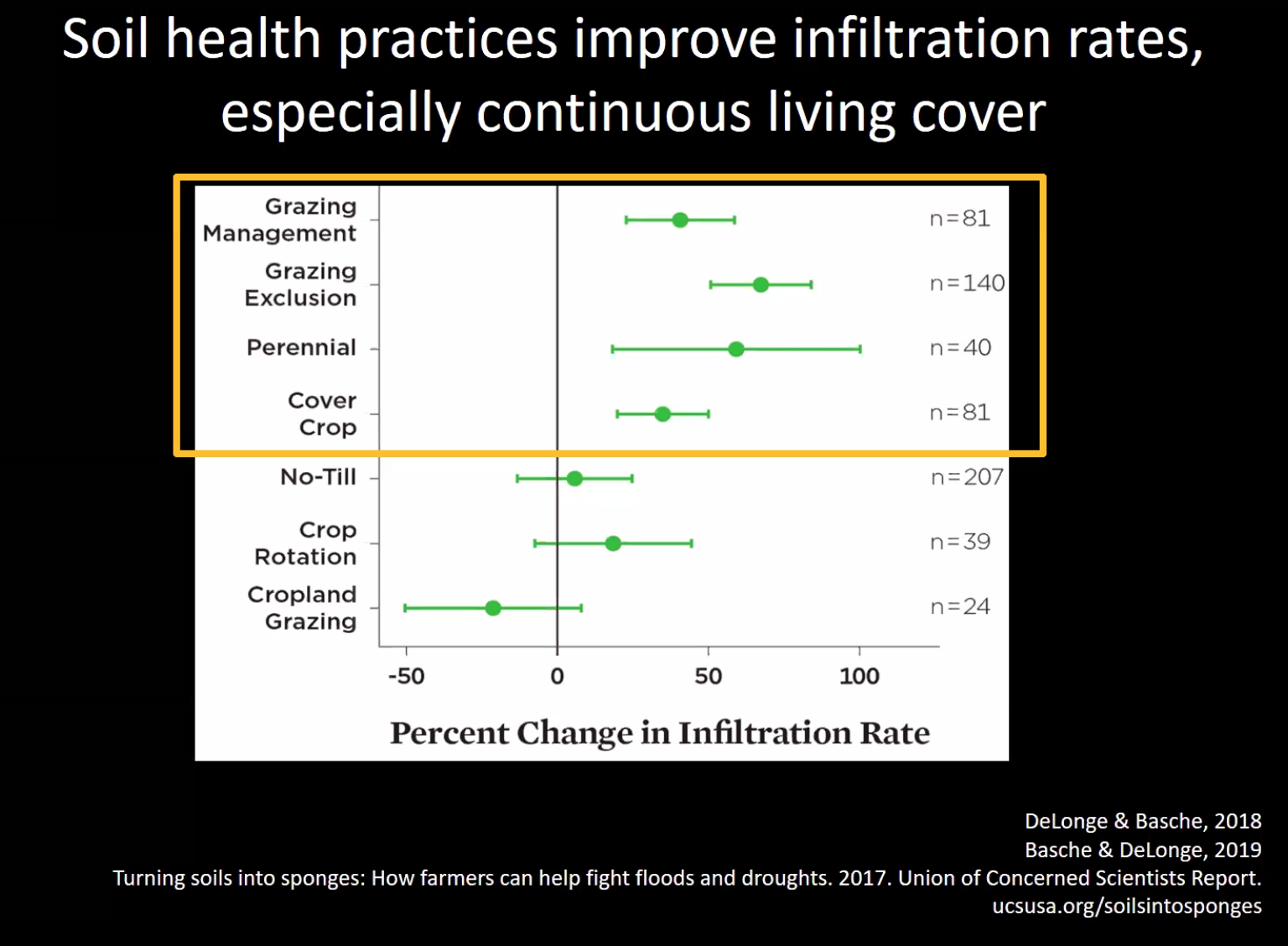
Mark Thompson, farmer/farm manager, Badger, IA
- Soil health and the soil armor provided by cover crops gives us insurance against weather extremes to ensure productivity now and for future generations.
- By planting green into growing cover crops and spraying them after planting, the dying mat of rye provides excellent weed control with minimal herbicide use.
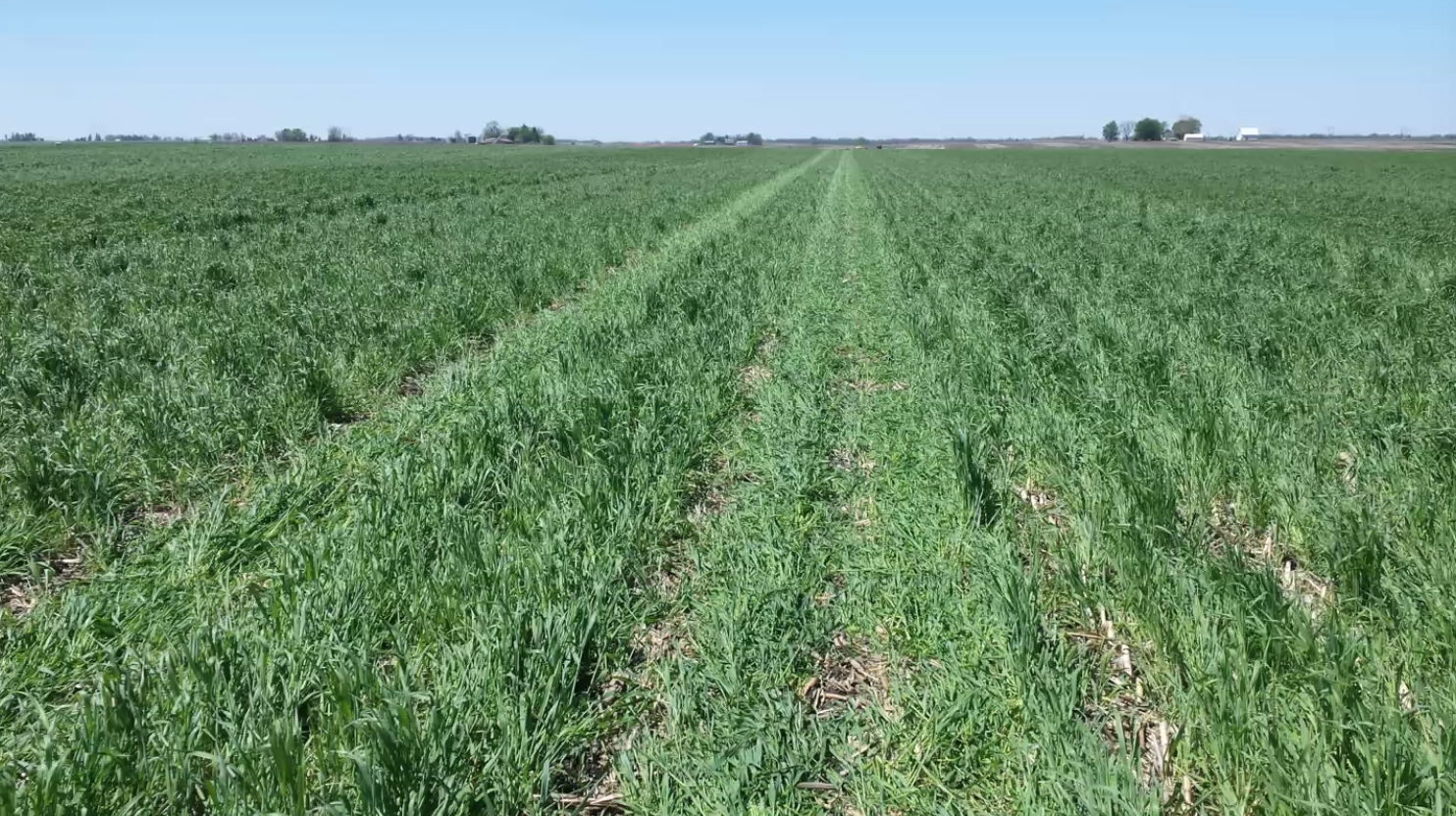
Jean Eells, landowner
- Don’t count your landowner out when seeking a partner for cover crops. Of the women landowners at my workshops, 70% are willing to take action to improve their farm. I worked with my farmer tenant to use no-till, strip till, and cover crops to improve the soil and reduce compaction. I even bought a roller-crimper for the farm.
Key Takeaways: Suppressing Weeds
Ruth McCabe, Heartland Cooperative agronomist
- Cover crops provide many benefits in a corn-soybean rotation: reduce or prevent soil erosion, capture volatile or mobile nutrients, improve soil health and soil structure, improve water infiltration and porosity, an excellent grazing opportunity, and weed control.
- Cover crops provide weed control in three ways: smother weeds through sheer volume of biomass, out-compete weeds for limited sunlight, water and nutrient resources, or through allelopathy where decomposing cover crop roots release compounds that inhibit the growth of small-seeded weeds.
- Important rule: Plan your cover crop the way you plan your cash crop. Learn species differences, know how they grow and die, and create numerous backup plans.
- Cereal rye is the “gateway drug” to get started with cover crops. Ideally, seed it into standing crops in August/September, when soybeans turn yellow and the corn grain-fill period is finished.
Rob Stout, farmer, Washington County
- I’ve used cover crops for 11 years, with the last six covering 100% of my acres. We used to have severe marestail problems in every field, but after 4 to 5 years of cover crops, we have zero marestail and very little giant ragweed.
- I’ve not seen any allelopathy in corn with a rye cover crop, but I add nitrogen at planting since my rye is taller and isn’t terminated until planting.
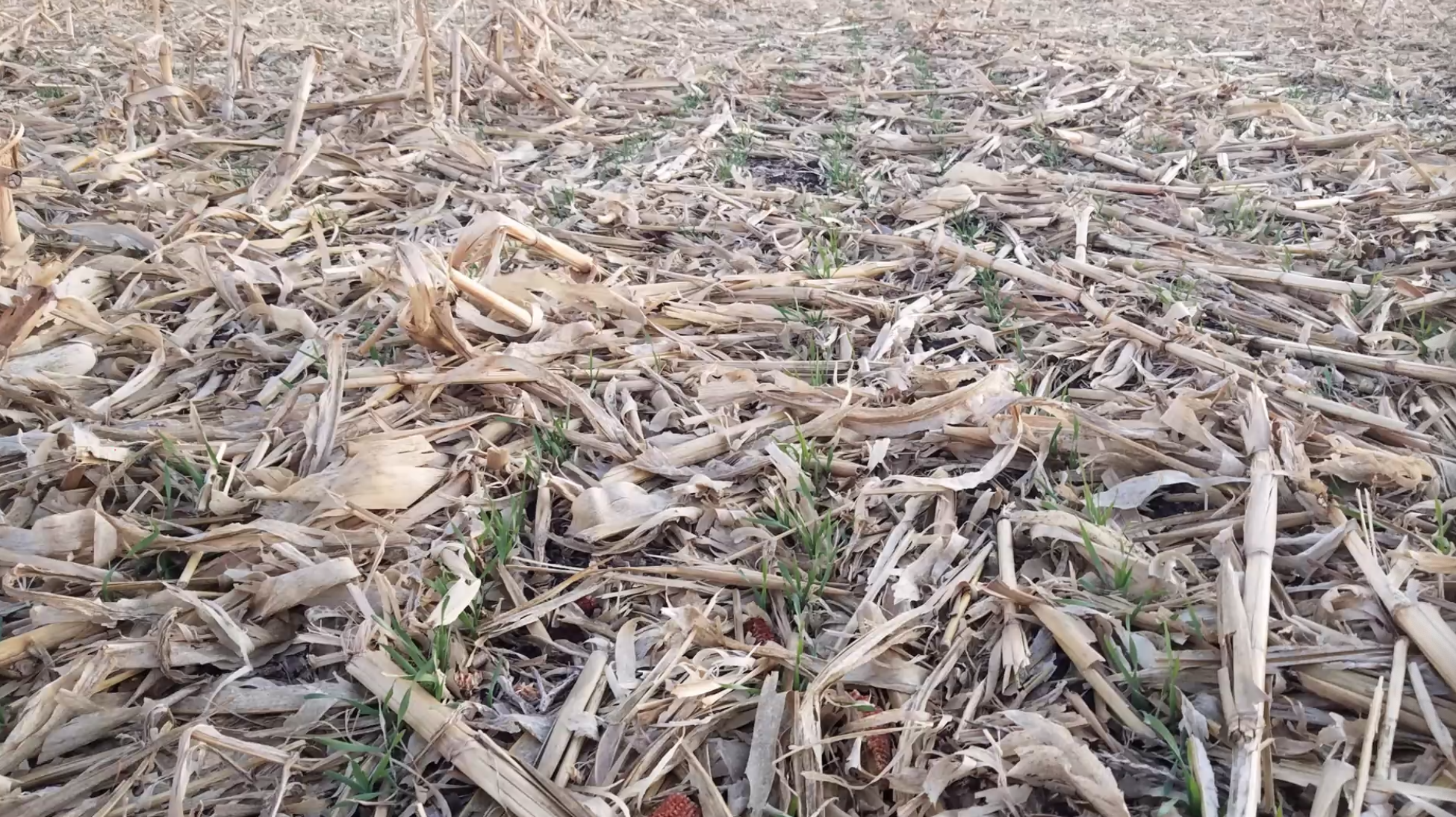
Rick Clark, farmer, Farm Green Consulting, Warren County, IN
- Our no-till cover crop system and five crop rotation have reduced our yield variation within fields from 28 bu./A to 4.7 bu./A.
- Our cereal rye cover crop biomass research shows (below) you absolutely shouldn’t terminate it right away in the spring. Our lab data (2x2 ft. biomass sample of rye seeded at 80 lbs./A) shows a doubling in biomass (2,000 to 4,000 lbs./A dry) comparing 12- to 18-inch tall rye. Also, note the sequestration of nitrogen that perhaps is taking the fuel away from the weeds’ ability to grow. The 28-inch tall rye has 6,800 lbs./A of biomass is what we need in our system to suppress weeds. If you look at the dead rye date, taken two months after termination, the biomass ends up at 3,500 lbs./A. The microbes have eaten almost half of the biomass. Since this field is going into soybeans, look at the potash released into the profile available to the crop.
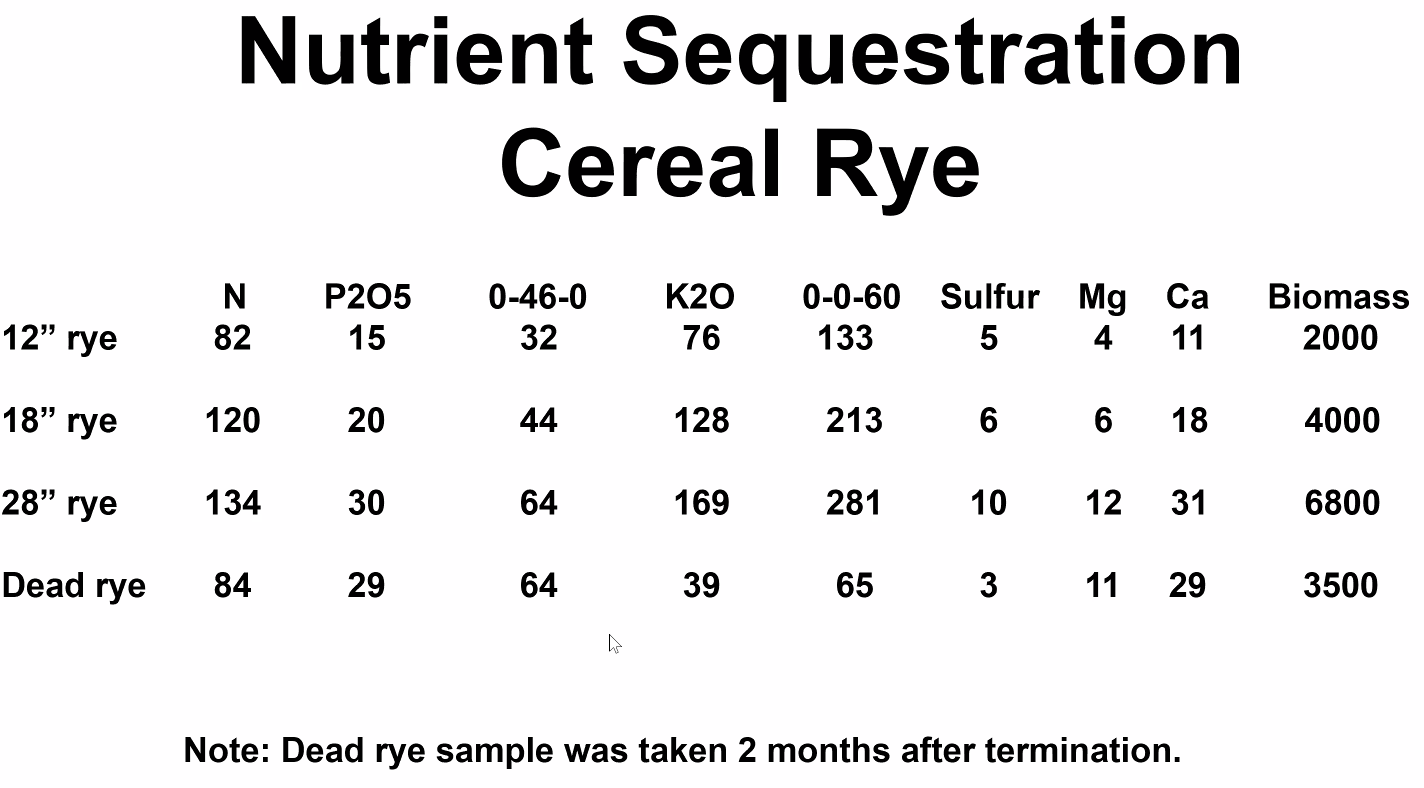
- Balansa Fixation clover, our main staple cover crop ahead of corn, is the fuel for corn and weed suppression. The data (below) shows incredible biomass growth in 4 days from June 4 to 8, plus fixation of 444 lbs. K2O and 262 lbs. N is amazing. Being on 20-inch rows of corn and soybeans, my 70/30 rule of thumb is 70% of weed suppression has to come from the cover crop and 30% from the cash crop canopy. You’ll also note the June 8 sample had 5,200 lbs./A organic carbon, which is when we plant corn. It took us about seven years in this cropping system to achieve these levels.
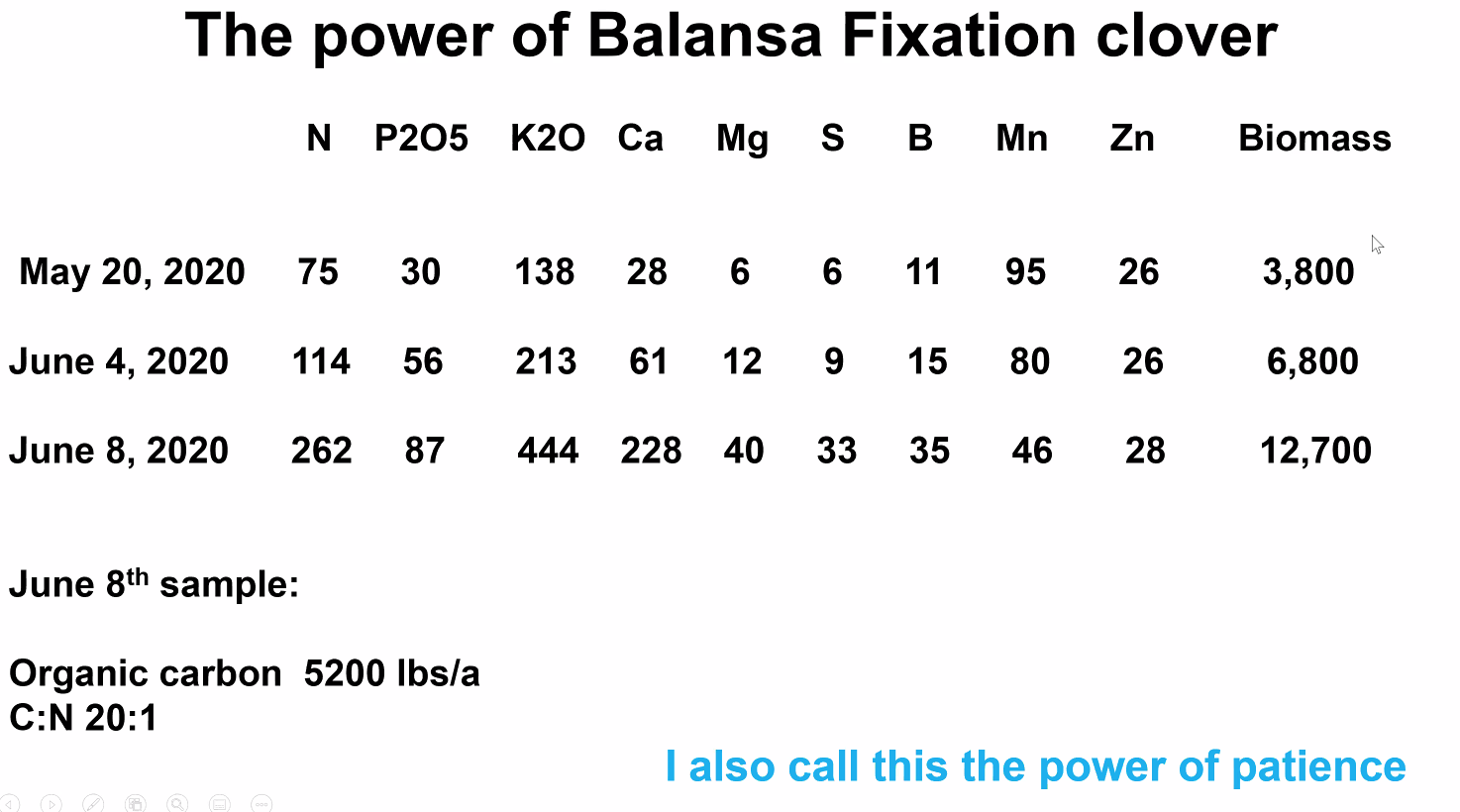
- In this system, we don’t apply starter, fungicide, insecticide, and seed treatment. We haven’t applied phosphorus, potassium, or lime in seven years and no nitrogen in two years. All soil tests have held steady from seven years ago.
- In this photo (below), we seeded a vigorous corn hybrid into an alfalfa cover crop, then roller-crimped at V1 to slow the alfalfa until the 20-inch-row corn (40,000 ppa seed rate) can canopy to terminate the alfalfa. Then the alfalfa releases nutrients and corn growth explodes.
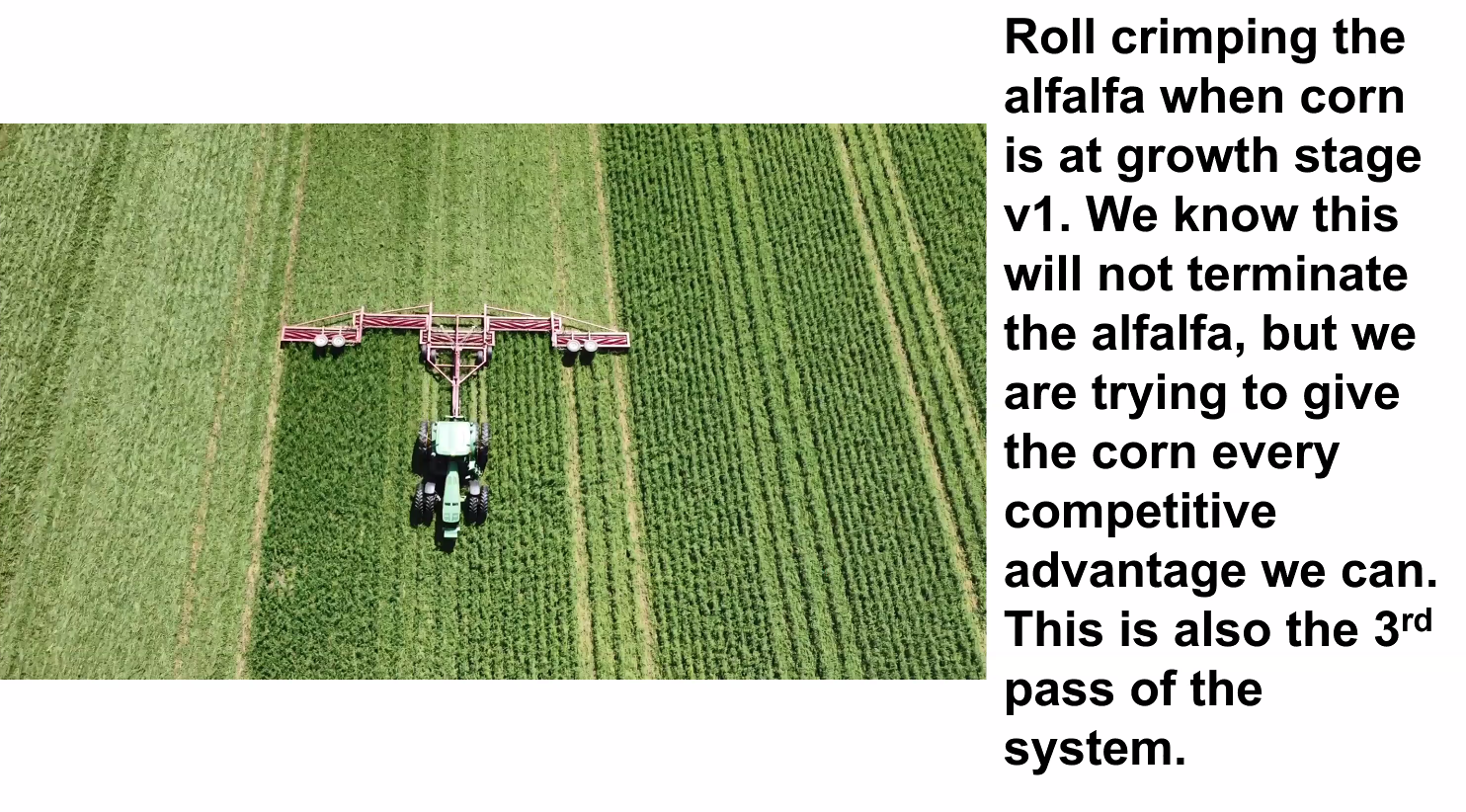
- Since our cover crop seeding in the fall is absolutely imperative, we have shifted to earlier maturing corn (from 110-166 to 98-106 days) and soybeans (from 3.0-4.2 to 1.7-2.6).
Key Takeaways: Livestock Lessons
Nathan Anderson, farmer, Cherokee County, IA
- Over the last three years, our cow herd has paid us $40 a day to do nothing for them. They graze cover crops on our cropland, which requires less feed, less protein supplement, less attention and work, less manure hauling, less yardage costs, and other benefits.
- A great way to start grazing cover crops is to plant cereal rye in the fall into standing corn or drilled after harvest, then graze it in the spring before soybeans, allowing your perennial pastures to green up. This spring growth also makes for better calving on cereal rye.
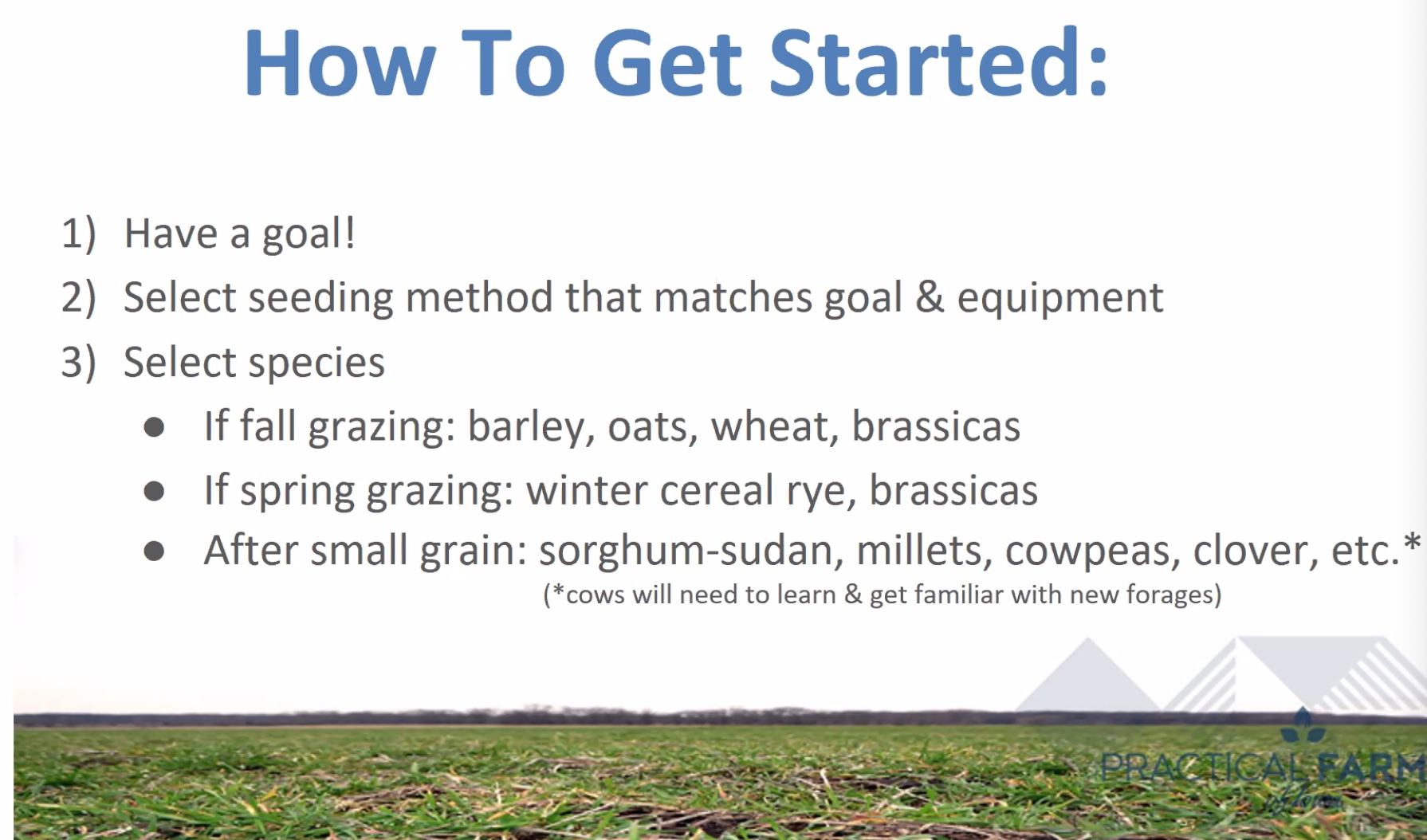
Meghan Filbert, Practical Farmers of Iowa, livestock program manager/farmer
- Our five years of cow/calf cover crop grazing research is proving economic benefit. For example, in 2018-2019, our five cooperator farmers realized an average net profit of $90/acre (given $150/ton hay) thanks to reduced feed costs.
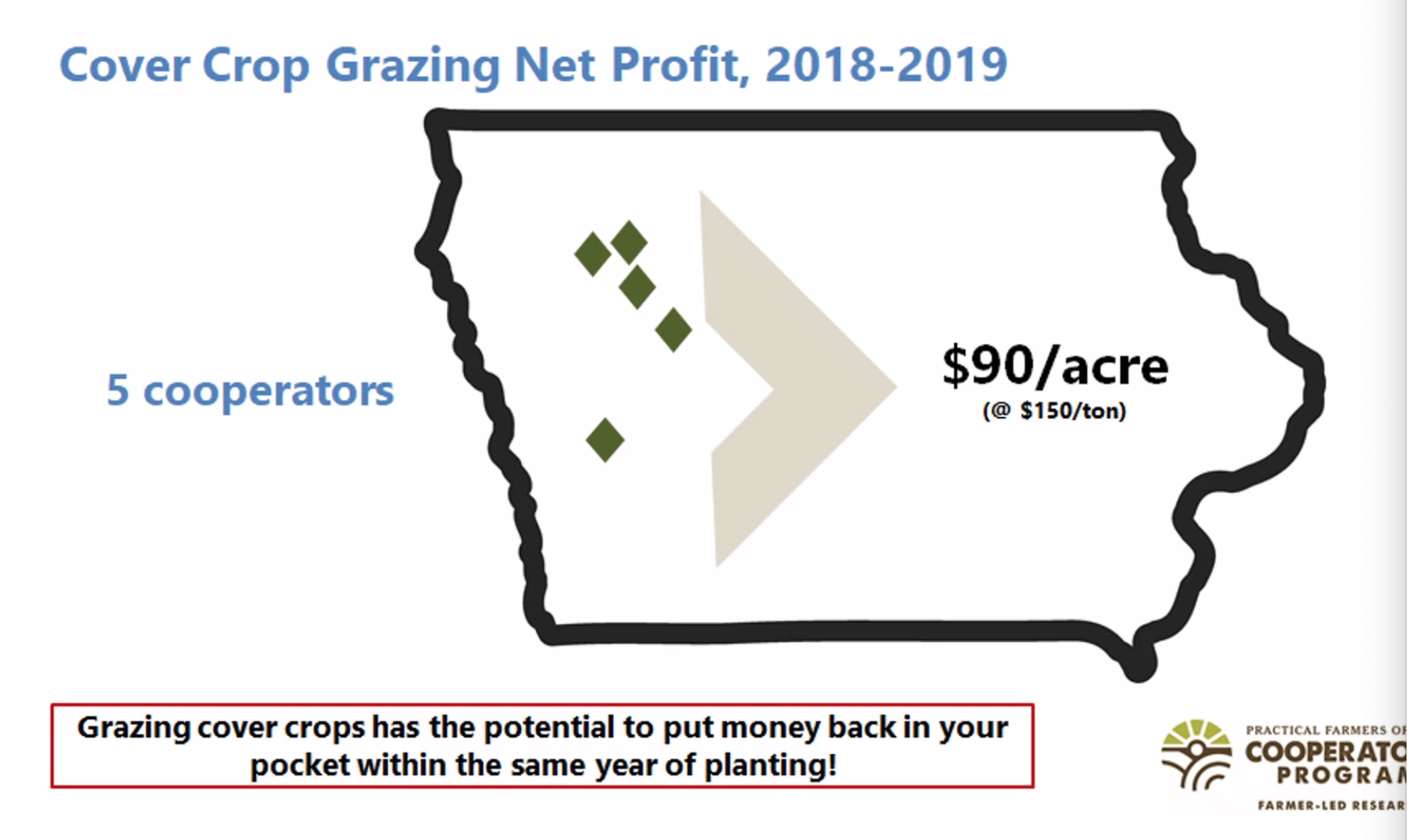
- Midwest Grazing Exchange is a free website that connects livestock owners seeking grazing with landowners who have cropland/pasture for grazing across six states.
Mary Drewnoski, University of Nebraska-Lincoln, beef systems specialist
- To graze cattle on cover crops in September-October or April-May, planting date is critical. If you can’t seed by September 1, don’t plan on fall grazing. It would be best to seed winter-hardy species for spring grazing.
- Oats and rapeseed that are seeded in late summer provide more pounds of gain per day and less expensive seed costs compared to oats-only cover crop. Forage quality remains high going into winter: November versus December TDN was 78% and 67%, respectively; protein was 23% in both months.
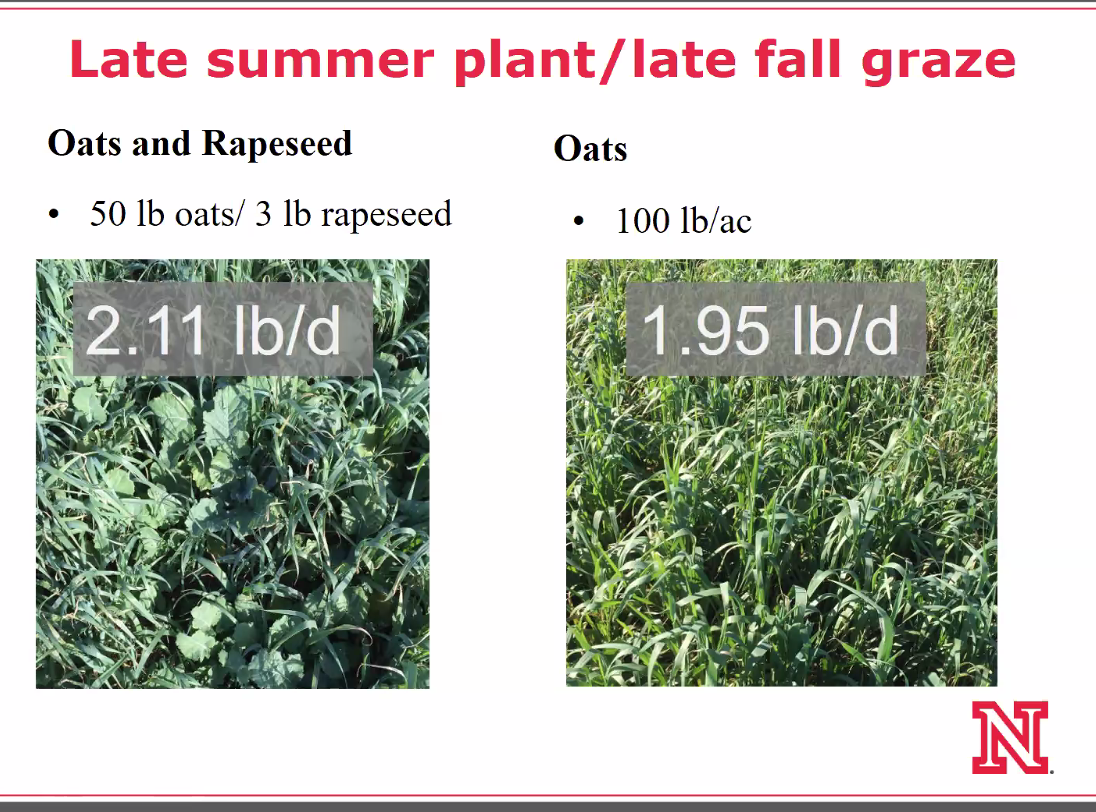
- For spring grazing, research shows good success with cereal rye, winter wheat, and triticale seeded in October. When grazing 700 lb. steers on 5-inch rye (2 head/acre, rotated when grass 2-inch tall among three field areas), we achieved 4 lbs./day gains at a cost of $0.18 per pound of gain.
Zack Smith, farmer, Winnebago County, IA
- After playing with strip intercropping for almost a decade, Smith and partner-farmer Sheldon Stevermer wanted to add livestock to the mix to harness natural cycles of a plant-animal ecosystem and find more profit. They launched Stock Cropper, an innovative mobile livestock grazing building that follows pasture strips between corn strips while sheep, goats, pigs, and chickens graze and grow.
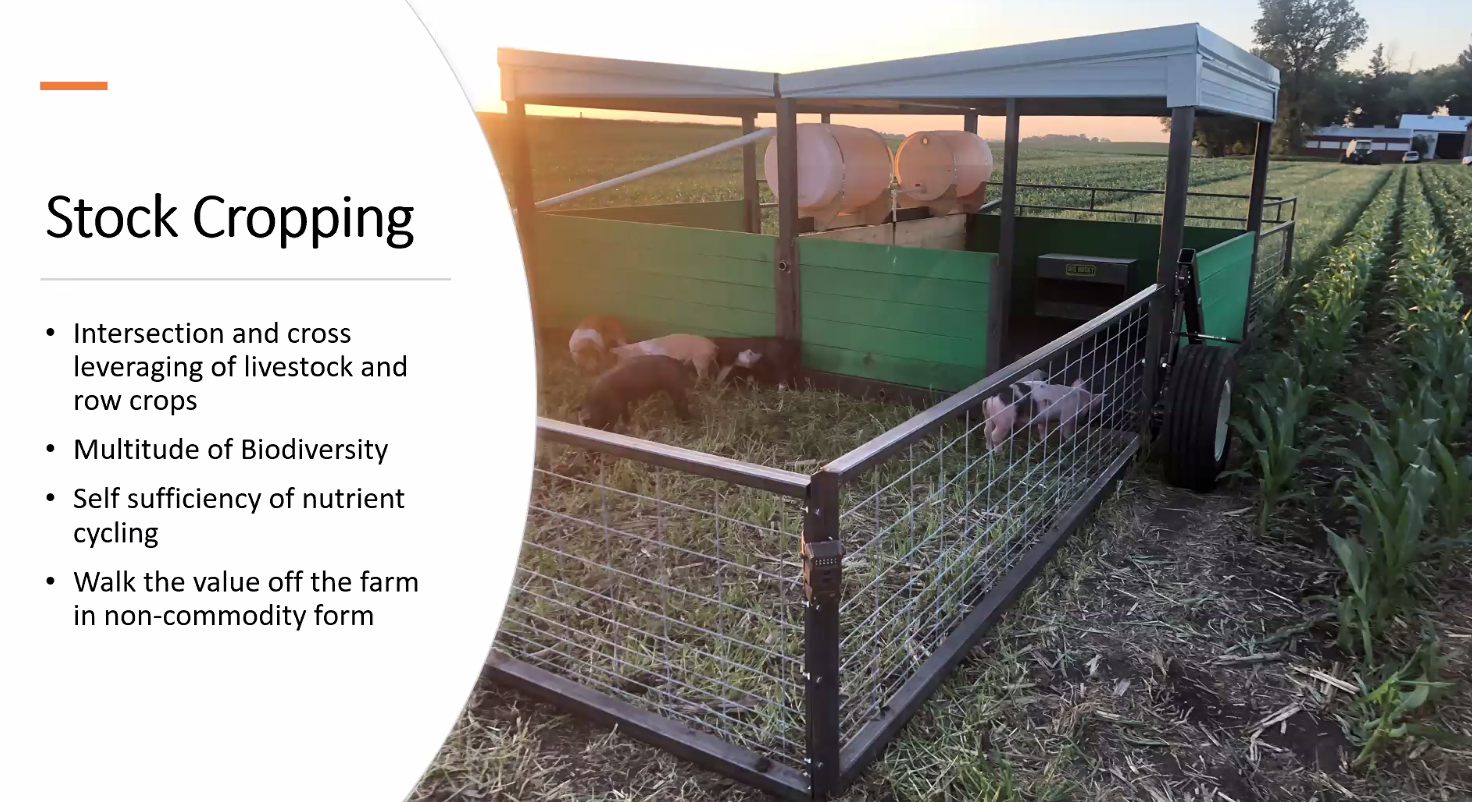
- This mid-August aerial photo (below) shows the three pasture strips and the ClusterCluck 5000 barn. The building moved daily, then twice a day as animals grew. They achieved their goal of marketing pasture-raised animals direct to consumers, plus free fertilizer to use for next year’s corn strip. And the corn yielded 260 bu./acre. For more details, visit their YouTube page.
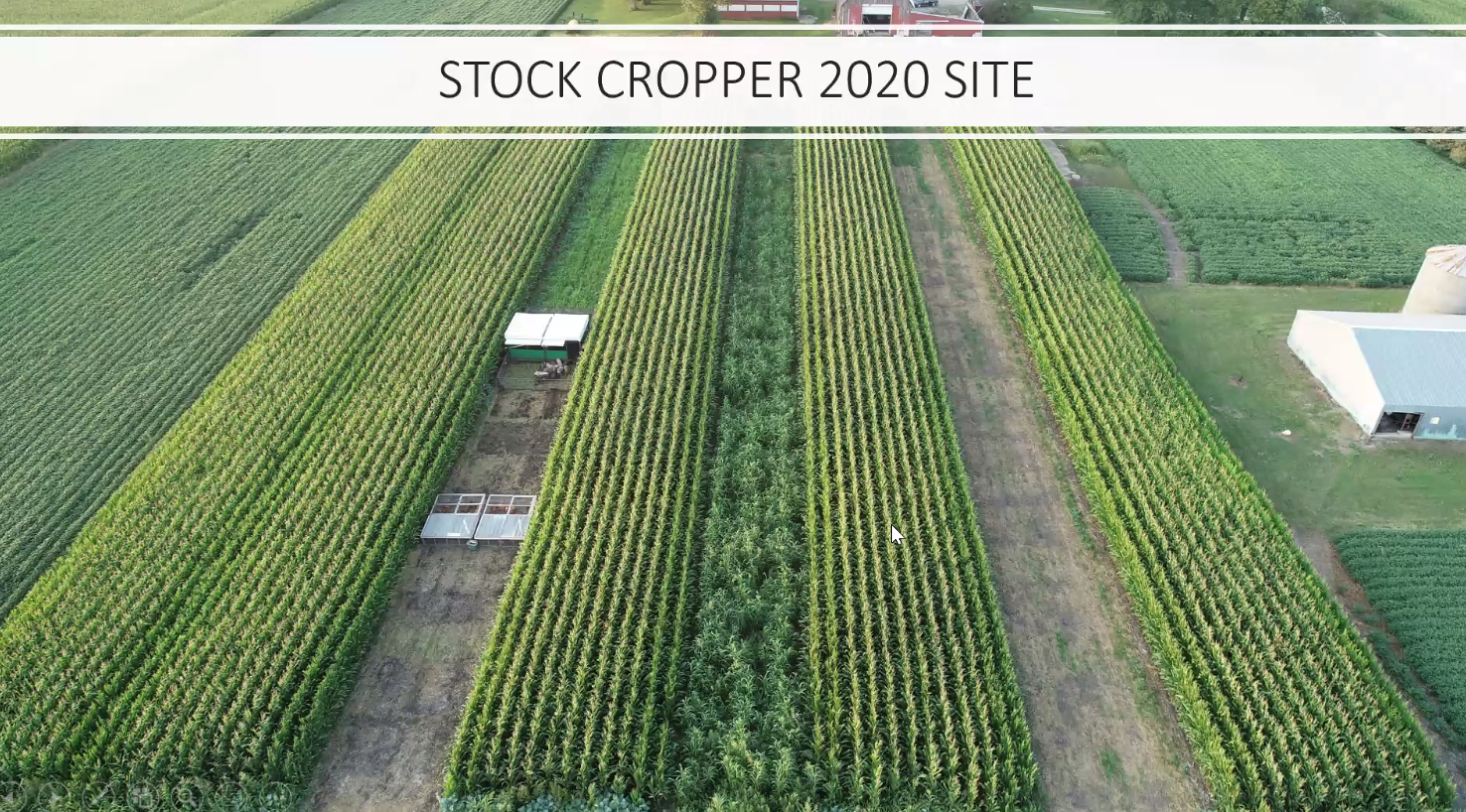
The following partners came together to plan the two-day event: Practical Farmers of Iowa, Coalition to Support Iowa’s Farmers, Iowa Learning Farms, Iowa Corn Growers, Iowa Soybean Association, Iowa Pork Producers Association, Iowa State University, Soil Health Partnership, Iowa Seed Association, Iowa Agriculture Water Alliance, Agribusiness Association of Iowa, Iowa Seed Corn Cover Crop Initiative, Natural Resources Conservation Service, and the Iowa Department of Ag and Land Stewardship.
